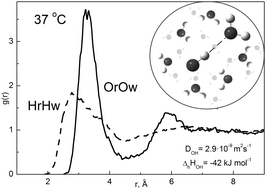Molecular dynamics study of the hydration of the hydroxyl radical at body temperature
Abstract
Classical molecular dynamics (MD) simulation of ![[n with combining macron]](https://www.rsc.org/images/entities/i_char_006e_0304.gif)
![[n with combining macron]](https://www.rsc.org/images/entities/i_char_006e_0304.gif)

* Corresponding authors
a Institute of Applied Radiation Chemistry, Technical University of Lodz, Zeromskiego 116, 90-924 Lodz, Poland
Classical molecular dynamics (MD) simulation of ![[n with combining macron]](https://www.rsc.org/images/entities/i_char_006e_0304.gif)
![[n with combining macron]](https://www.rsc.org/images/entities/i_char_006e_0304.gif)

 Please wait while we load your content...
Something went wrong. Try again?
Please wait while we load your content...
Something went wrong. Try again?
A. Pabis, J. Szala-Bilnik and D. Swiatla-Wojcik, Phys. Chem. Chem. Phys., 2011, 13, 9458 DOI: 10.1039/C0CP02735A
To request permission to reproduce material from this article, please go to the Copyright Clearance Center request page.
If you are an author contributing to an RSC publication, you do not need to request permission provided correct acknowledgement is given.
If you are the author of this article, you do not need to request permission to reproduce figures and diagrams provided correct acknowledgement is given. If you want to reproduce the whole article in a third-party publication (excluding your thesis/dissertation for which permission is not required) please go to the Copyright Clearance Center request page.
Read more about how to correctly acknowledge RSC content.
 Fetching data from CrossRef.
Fetching data from CrossRef.
This may take some time to load.
Loading related content
